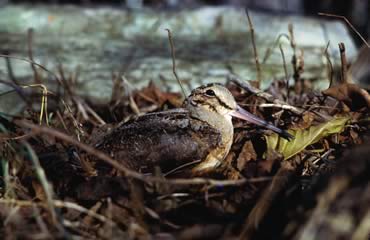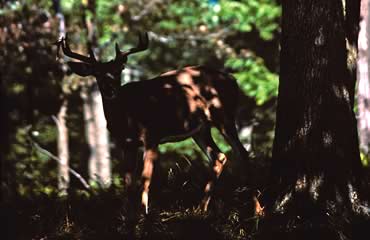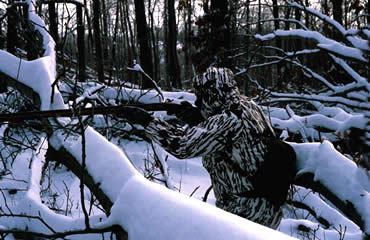We’ve learned some of our best concealment tricks from the original masters.
My thoughts should have been on deer, but the occasional scratch in the dry leaves below my treestand commanded my attention. After several minutes, a glimpse of movement in the mottled leaves revealed the oval form of a woodcock going about its business of poking its stiletto beak into soft soil in search of an earthworm breakfast.
The comical-looking timberdoodle, like many critters hunters encounter, is wonderfully adapted to melting into its woodland-floor habitat. Its mottled-and-barred brown, bronze, gray and black plumage conceals it perfectly against the dead-leaf pattern of the forest floor.
That’s just one wild creature whose existence relies on effective camouflage. For both hunter and hunted, camouflage of one sort or another is the required dress. Birds, mammals, reptiles, amphibians and fish wear their cryptic patterns and colors, blending with shrubs, leaves, rocks, snow and tree trunks.
 Sharp-eyed and stealthy human hunters are frequent witnesses to the effectiveness of camouflage, and we congratulate ourselves upon discovering a green snake blending in with summer’s foliage, or when we stumble upon a snapping turtle imitating a rock. More often, I suspect, we pass within feet of camo-clad creatures that instinctively freeze at the first sign of danger. We wander past without a clue as to how close we’ve been.
Sharp-eyed and stealthy human hunters are frequent witnesses to the effectiveness of camouflage, and we congratulate ourselves upon discovering a green snake blending in with summer’s foliage, or when we stumble upon a snapping turtle imitating a rock. More often, I suspect, we pass within feet of camo-clad creatures that instinctively freeze at the first sign of danger. We wander past without a clue as to how close we’ve been.
Take a recent spring gobbler season when a gray-phase screech owl ended its nocturnal hunt by flitting into a white pine no more than a dozen yards from where I was sitting. I watched through a binocular as it pressed itself against the trunk, virtually disappearing before my eyes. Had I not witnessed its arrival, I’d have walked by its hiding place, never knowing it was there.
Variations on the Camo Theme
Not all camouflaged creatures dissolve perfectly into their environments, but some come close. The gray treefrog is so well matched to furrowed bark that it’s difficult to see even when viewed from a foot or two away. Its warty skin and changeable coloration are the essence of concealment.
Another slow-change artist is the green anole lizard (often mistakenly called “chameleon”) which I’ve had crawl onto my own camo coat during turkey and deer hunts in Alabama and Mississippi. More than once, I’ve marveled at the anole’s visible shift from green to a mottled brown as it crawled across my Realtree or Mossy Oak and marvelously took on my garb’s shading and coloration.
 Yet another type of animal camo is known as disruptive coloration, in which body colors are broken up into bars, bands, spots, stripes and meandering lines. The ground-nesting killdeer is a prime example. Humans or predators looking its direction have difficulty seeing where the bird ends and its background begins, as its outline is effectively broken into a jumble of unattached forms. A chipmunk’s bold stripes, and the contrasting bands on a copperhead offer similar examples of disruptive coloration.
Yet another type of animal camo is known as disruptive coloration, in which body colors are broken up into bars, bands, spots, stripes and meandering lines. The ground-nesting killdeer is a prime example. Humans or predators looking its direction have difficulty seeing where the bird ends and its background begins, as its outline is effectively broken into a jumble of unattached forms. A chipmunk’s bold stripes, and the contrasting bands on a copperhead offer similar examples of disruptive coloration.
Yet another type of deception is seasonal dimorphism, best exhibited by the snowshoe hare and the ptarmigan, which change from brown to white with the shift of seasons. However, sometimes such handy adaptations work against them when a winter landscape becomes barren of snow.
Whitetail Camo
Yet another form of camouflage known as counter-shading is demonstrated by everything from brook trout and bluebirds to mice and deer. These animals are darker on their backs than on the undersides which, at first thought, might not seem to offer much advantage. Consider, however, that these animals are lighted from above with portions of their undersides in deep shadow, breaking up their silhouette. The belly is always white no matter if on a diminutive Florida Keys doe or a northern Saskatchewan trophy buck.
 As one writer described it, “the white underbelly offsets the deer’s shadow cast on the ground, reducing the chance that they’ll be seen by predators.” The contrasting shades of hair reduce the revealing three-dimensional appearance a deer exhibits when in the open and breaks up and blends it to its environment when viewed through brush or downward from a treestand.
As one writer described it, “the white underbelly offsets the deer’s shadow cast on the ground, reducing the chance that they’ll be seen by predators.” The contrasting shades of hair reduce the revealing three-dimensional appearance a deer exhibits when in the open and breaks up and blends it to its environment when viewed through brush or downward from a treestand.
Of course, deer living in various places across the whitetail’s vast range vary in coloration, with the northernmost subspecies exhibiting darker fall and winter coats than those living in prairie, grassland and the Deep South.
The most effective whitetail camouflage is shown by fawns, whose dappled hide is interrupted by as many as 300 spots on its back and sides. Sunlight filtering through the treetops and understory casts shadows, blending the fawns with the leaf-littered woodland in which they typically bed.
As fawns mature, the spots gradually turn from white to beige. By early fall, when the winter coat begins to grow and the reddish summer coat is shed, the spots are lost.
I was able to see the woodcock on that fall morning because it moved, revealing its position despite the magic of its disruptive dress. Had I been a hawk or sharp-eared fox seeking a meal, its audible scratchings would have been a dead giveaway.
Of course, it’s important to always consider that errant movement on the part of hunter or hunted — the flash of an unmasked face or the flick of a deer’s tail or ear — is enough to send a signal that something’s amiss. Then even the best camouflage won’t do the job.
This article was published in the December 2007 edition of Buckmasters Whitetail Magazine. Join today to have Buckmasters delivered to your home.